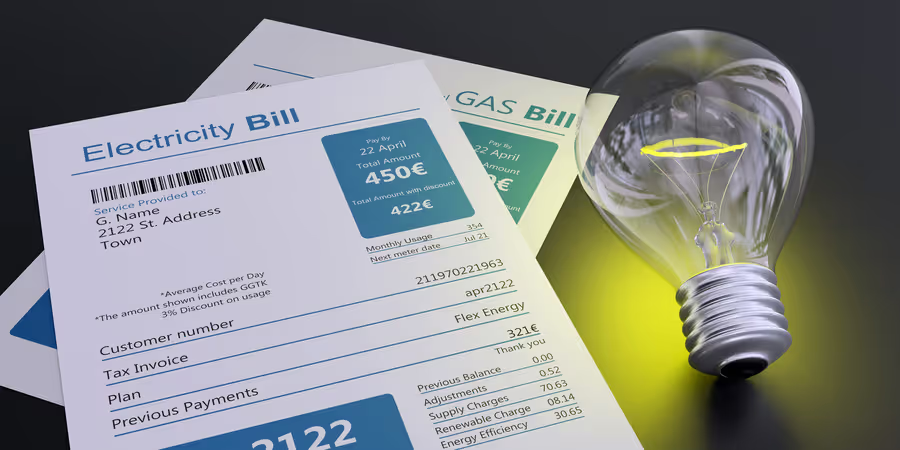If you’re self-employed, keeping a close eye on your business costs is second nature. But one area that’s often overlooked is the VAT on electricity and gas.
Your VAT rate on energy bills depends on your usage and business setup. It could be 5% or 20%, but many self-employed people are incorrectly charged.
Why VAT on electricity and gas matters for small businesses
VAT is charged on most goods and services in the UK, and energy is no exception. The standard VAT rate is 20%, but for qualifying electricity and gas usage, this reduces to a 5% VAT rate.
If you’re running a small business—especially from home or from a modest commercial unit—understanding which rate applies is crucial. It could potentially lower your bills and lead to a significant saving.
Who pays 5% vat on electricity and gas?
In general, the 5% VAT rate applies in two key situations relevant to self-employed people:
1. Low usage commercial premises
If your business uses less than 33 kWh of electricity or 145 kWh of gas per day, your supply qualifies for the reduced rate.
2. Domestic use
If you're working from home, or your business energy supply is mostly for domestic purposes (for example, a flat with a small home office), you may also fall under the 5% rate.
Now let’s look at this in more detail.
What is the “De Minimis” rule for businesses?
If your commercial energy usage is relatively low, you may fall under what’s known as the de minimis limits.
This is particularly relevant for sole traders, freelancers, or small businesses operating from:
- Small offices or co-working spaces
- Studios or workshops
- Retail units with low footfall
- Garden offices or converted rooms in a home
The thresholds (as mentioned above) are:
- 33 kWh per day for electricity (around 1,000 kWh per month)
- 145 kWh per day for gas (around 4,397 kWh per month)
If your usage falls below these levels, your supplier should automatically apply the 5% VAT rate to your bills—even if the property is classified as commercial.
If your usage is below the threshold but you’re being charged 20%, you may be able to claim a refund going back up to 4 years.
When the 20% VAT Rate Applies
You’ll be charged the standard 20% VAT rate on your energy if:
- You work from commercial premises and your energy use exceeds the de minimis limits
- You’re running a larger business operation, such as a shop, café, or production unit
- Your supply is entirely non-domestic, and you’ve not informed your supplier of any eligible reduced usage
This is the default rate for most commercial energy supplies. However, some small businesses fall into it unnecessarily, simply because they haven’t declared their eligibility for the reduced rate.
Working from home? Here’s what that means for VAT
If you’re self-employed and working from home, whether full-time or just a few days a week, your electricity and gas supply will usually fall under domestic use. That means you’ll automatically be charged the reduced 5% VAT rate, just like any household.
You don’t need to do anything to get this rate—your supplier applies it by default, because the energy is going to a domestic property.
But here’s where it gets interesting from a business point of view:
- You can’t usually reclaim VAT on domestic energy bills, even if you're VAT registered. That’s because the supply is for mixed use (both business and personal), and HMRC doesn’t allow VAT reclaims on personal consumption.
- However, you can still claim part of the bill as a business expense when working out your income tax. The proportion depends on your setup—for example, what percentage of your home is used for work, and how many hours you spend working there.
So while the 5% VAT rate keeps your bills lower, it also limits what you can claim back on your VAT return. If you have a dedicated garden office or converted room solely for business, it might be worth speaking to an accountant to see if any exceptions apply.
Mixed use: home and business combined
Some self-employed people operate from mixed-use premises. For example, a shop with a flat above or a studio attached to your home.
If more than 60% of your energy use is domestic, the entire supply can be charged at 5%. If less than 60% is domestic, the supplier will usually split the bill and apply 5% to the domestic portion and 20% to the rest.
To benefit from this, you may need to:
- Submit a VAT declaration form to your supplier.
- Provide evidence or estimates of your split energy usage.
Trust us, it’s worth the admin. This kind of review can lead to ongoing savings and potentially a retrospective refund.
{{ltd-guide}}
Why are there two VAT rates on energy?
The VAT difference exists because the UK government wants to make energy more affordable for households and low users, while still charging the standard rate for higher or entirely commercial use.
5% VAT Rate – Reduced rate for essentials
This reduced rate is meant to support affordability for:
- Domestic energy use (homes and residential premises)
- Charities
- Small businesses or premises with low energy usage (under specific thresholds)
It's a form of tax relief—treating energy as a basic necessity rather than a luxury.
20% VAT Rate – Standard commercial rate
This is the standard VAT rate in the UK, applied to most goods and services. It applies to:
- Businesses with higher energy usage
- Commercial premises
- Energy use that's not domestic or below threshold
The logic is that heavier users and larger businesses can absorb the higher VAT, and they're also more likely to be VAT registered. Meaning they can reclaim the cost anyway.
How to check what you’re being charged
1. Look at your energy bill: It should clearly show whether you’re being charged VAT at 5% or 20%.
2. Check your usage: Compare your kWh consumption to the de minimis thresholds.
3. Review your business setup: Are you working from home? From a small office? Are you on a domestic or business tariff?
4. Speak to your supplier: They can confirm your current VAT status and help you apply for the reduced rate if you qualify.
What if you’ve been overcharged?
It’s not uncommon for small business owners to discover they’ve been paying 20% VAT when they should have been paying 5%.
If you think this applies to you:
- Gather your energy usage records
- Request a VAT declaration form from your supplier
- Ask for a refund for the overpaid VAT—suppliers can usually go back four years
You’ll also want to make sure the correct rate is applied going forward. Don’t assume your supplier has automatically placed you in the right category.
Can you reclaim any VAT on energy bills?
If you’re VAT registered, you might be wondering whether you can reclaim VAT on your energy bills.
The answer depends on how and where you work:
- If you work from commercial premises, and pay 20% VAT, you can usually reclaim the VAT on your returns.
- If you work from home, and your supply is domestic at 5%, you can’t reclaim VAT unless the supply is 100% for business (which is rare).
- If you’re on the 5% rate for low usage commercial supply, you can reclaim it, but the amount is lower (5% instead of 20%).
In all cases, you need to keep proper records and only claim for business use. HMRC may ask for justification if your claim seems high.
How Crunch can help
Not sure if you’re on the right VAT rate for your energy bills? You’re not alone.
At Crunch, we don’t handle energy accounts, but we do help self-employed people stay on top of their VAT. If you’re unsure how your energy bills fit into your VAT returns or whether you can claim anything back, our expert accountants can guide you through it.
It’s one more way we can help you keep your finances in check and stop unnecessary costs slipping through the cracks.
Need help with your VAT returns? Find out more about how we can help with online VAT submissions.


.svg)

.svg)



.webp)




.avif)









